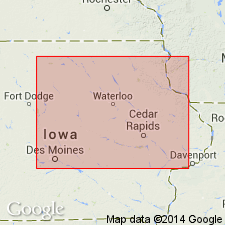
- Usage in publication:
-
- Rapid Member
- Modifications:
-
- Revised
- Overview
- Biostratigraphic dating
- AAPG geologic province:
-
- Iowa shelf
- Illinois basin
- Wisconsin arch
- Lincoln anticline
Summary:
Reassigned as a member of Little Cedar Formation (new) of Cedar Valley Group (rank raised). Overlies Solon Member (reassigned) of Little Cedar. Underlies Coralville Formation. Dominated by argillaceous calcilutite. Divided into a lower fossiliferous calcilutite; a middle unit of interbedded fossiliferous calcilutite and non- to sparsely fossiliferous burrowed calcilutite that is capped by two widespread coralline biostromes; upper unit is glauconitic, commonly cherty with prominent hardgrounds. Varies in thickness from 2 m (south) to 5 m (north). Can be recognized across southeast and east-central IA (Iowa shelf) and adjacent IL [Illinois basin?, Wisconsin arch?], and MO [Lincoln anticline?]. Conodonts span the Lower and Upper HERMANNI-CRISTATUS Lower SUBTERMINUS subzones. Has a diverse brachiopod-dominated fauna, corals, rugosans, bryozoans, trilobites, ostracodes, nautiloids, tentaculitids, chitinozoans, sponge spicules, fish debris. Lower part deposited in open marine subtidal environment; middle part deposited in quiet water; upper part shows shallowing. Of Givetian, late Middle Devonian age. Nomenclature charts, graphic sections.
Source: GNU records (USGS DDS-6; Denver GNULEX).
For more information, please contact Nancy Stamm, Geologic Names Committee Secretary.
Asterisk (*) indicates published by U.S. Geological Survey authors.
"No current usage" (†) implies that a name has been abandoned or has fallen into disuse. Former usage and, if known, replacement name given in parentheses ( ).
Slash (/) indicates name conflicts with nomenclatural guidelines (CSN, 1933; ACSN, 1961, 1970; NACSN, 1983, 2005, 2021). May be explained within brackets ([ ]).

